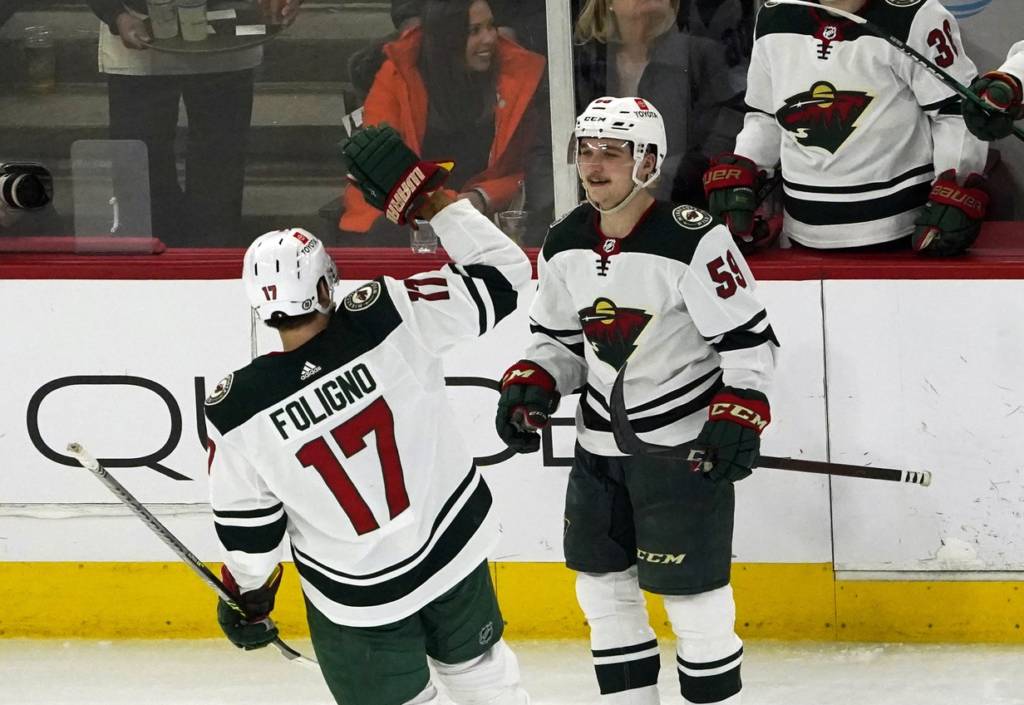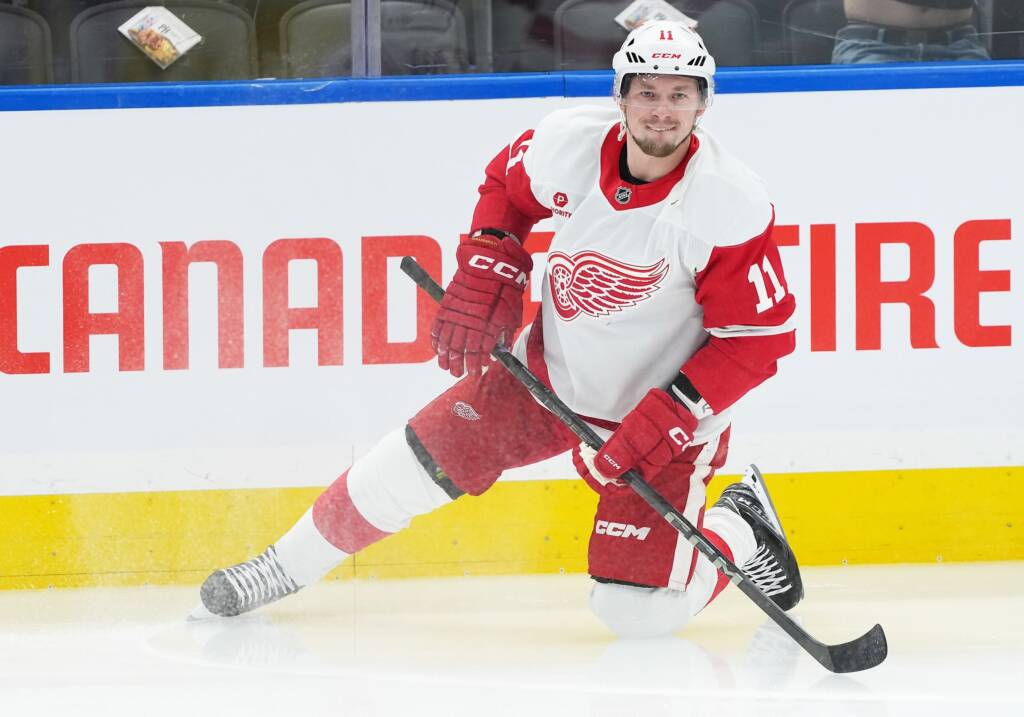Four years ago, the Minnesota Wild’s pool of defensive prospects was so dry, you could skateboard in it. Having a core of veteran Ryan Suter, then Jared Spurgeon, Jonas Brodin, and Matt Dumba in their primes, there was little need. And with general manager Chuck Fletcher selling nearly every draft pick come trade deadline time, there was little ammunition to stock up on defense.
By the time the 2018 draft rolled around, Minnesota’s top defensive prospect was… Louie Belpedio? Carson Soucy? Whichever it was, the dropoff beyond them was noticeable. Attempting to add to the pool with Filip Johansson didn’t turn out like Minnesota had hoped, either.
So when Bill Guerin took over the front office, one of his priorities was to build a defensive pipeline from scratch. He started in 2020, acquiring Calen Addison from the Pittsburgh Penguins in the Jason Zucker trade. In 2020, Guerin and head scout Judd Brackett bolstered the left side of the organization, selecting mobile, nasty defensemen Ryan O’Rourke and Daemon Hunt back-to-back.
They weren’t done in 2021, either. After trading up for Jesper Wallstedt, Brackett snagged two more lefties in Carson Lambos and Jack Peart with the 26th and 54th overall picks. Now, the Wild targeted the right side of the blueline. The organization got Brock Faber as one of their two prizes in Wednesday’s Kevin Fiala trade.
Suddenly, the Wild have gone from a barren wasteland to a potential logjam. And hey, with the right opportunity, they might still add more, according to Brackett when he spoke with the media on Thursday.
“We’re going to stay focused on best available [players],” Brackett said. “We’re talking about 17-year-old players, so there’s a maturation process and some development. Roster composition is something we’re obviously aware of, but less so when it comes to drafting.”
Fans may raise an eyebrow should Minnesota snag a defenseman at 19 or 24 or even trade up to acquire one. They shouldn’t, though. If the Wild grab a defenseman like Denton Mateychuk, Kevin Korchinski, or Lane Hutson in the first round, that gives them a player with tremendous upside. Even at defense, getting that sort of upside in a pick will help soothe any concerns about the return for Fiala.
Having that extra pick from Wednesday’s trade could help them move up the board for Korchinski, a consensus top-15 player, or take a risk on the smaller Mateychuk or Hutson.
“Absolutely,” Brackett responded when asked about it. “When you’ve got a little extra ammo, you’re maybe a little less averse to risk, so you might take a little bigger swing knowing you have some extra picks coming. But we build the [draft] list, we work off the list, and that discussion comes in even before that second first-round pick is acquired.”
Where are all these kids going to play?
The Wild have Spurgeon and Brodin patrolling the top of the depth chart for another five and six years, respectively. With Addison and Faber in the picture, there’s a path to the Wild parting ways with Dumba in the next year. That opens a spot, but Alex Goligoski and Jon Merrill are both serving multi-year deals.
Next year, that’s up to six defensemen competing for perhaps three spots. And that precludes any veterans they may add to the organization in the meantime.
So what do the Wild do with this glut of prospects? Figure out who the odd man out is and preemptively trade them for a forward prospect or pick? Maybe cash in on a prospect with some pedigree to facilitate a big move?
Those are certainly ways Minnesota can go, but here’s another: Sit on that surplus. What’s the rush to trade any prospect at all?
The common wisdom in baseball is that you can’t have too much pitching. Isn’t that the same thing for defensemen in hockey? Especially since the players bring different skills to the table but share some important things in common.
Brackett put out his playbook for picking the ideal defenseman when asked about what defines this next wave. “When we’re looking at defensemen, you’ve got to have hockey sense, and you have to have mobility in this day and age,” Brackett explained. “Maybe they have a defining area where it may be their strong suits, but we want guys who can close gaps, can play an up-tempo game and contribute in all three zones.”
That sounds a lot like the Colorado Avalanche’s current blue line, no? The Avs aren’t worried that super-talented Bowen Byram is currently stuck behind Devon Toews and Sam Girard on the depth chart. If the Wild ever have to worry about something similar with their defense prospects, it’s a pretty great “problem” to have.
Look at where Minnesota was at a few years ago with forwards. They had big-ticket prospects in Marco Rossi and Matt Boldy but were very deep with other prospects. Adam Beckman, Alexander Khovanov, Marat Khusnutdinov, and Vladislav Firstov were all higher picks with Top-6 upside.
Boldy paid off this past season, putting together a Calder-caliber season, and Rossi may follow those footsteps last season. Last year, though, Beckman and Khovanov hit some snags in their development. Firstov had an up-and-down season at UConn before jumping to the AHL. Khusnutdinov signed a contract keeping him in the KHL through spring 2024.
The lesson is that stuff happens, and stuff’s gonna happen with this defense group. Lambos, Hunt, and O’Rourke missed some games this year. Could that be a problem down the road for any of them? Some of these players won’t quite develop; if they do, they might become third-pairing types rather than Top-4 staples.
As deep as Minnesota’s prospect pool is on the blueline, Hockey Prospecting projects them to yield just 4.1 NHL defensemen. That also includes lower-ranked prospects like Kyle Masters, Marshall Warren, and Simon Johansson. Can good scouting beat the odds? Sure. But it won’t take many bad breaks, or even batches of average luck, for the Wild to go from We have too many defensemen to play to We need another defenseman.
Besides, there are injuries at the NHL level, and those happen every season. We saw how much less effective Minnesota was when Spurgeon, Dumba, or Brodin were hurt last season. Having a wealth of NHL-ready defensemen on standby is good when they’re your insurance against playing third-pairing guys or AHL veterans well above their skis.
Once the standard attrition rate hits the Wild’s developing class, Minnesota may be glad they didn’t see someone like Addison or Lambos as expendable and move them out. If Spurgeon gets hurt in training camp one year, they might thank their lucky stars they didn’t pass on a Mateychuk just because they had defensemen at the time. Beefing up the blueline pipeline is a great way to ensure pucks stay in a pipeline moving towards the offensive zone, and Minnesota shouldn’t pump the breaks on that quest just yet.

